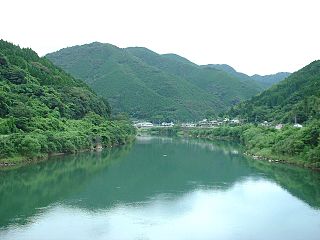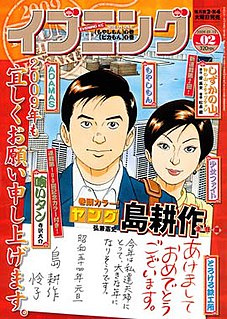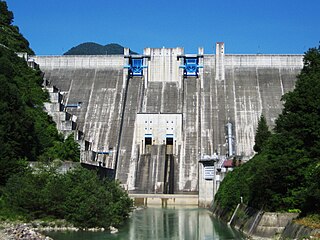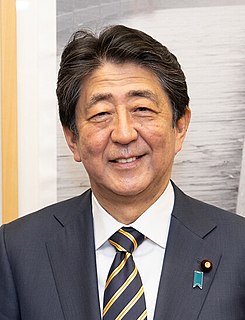
A dam is a barrier that stops or restricts the flow of surface water or underground streams. Reservoirs created by dams not only suppress floods but also provide water for activities such as irrigation, human consumption, industrial use, aquaculture, and navigability. Hydropower is often used in conjunction with dams to generate electricity. A dam can also be used to collect or store water which can be evenly distributed between locations. Dams generally serve the primary purpose of retaining water, while other structures such as floodgates or levees are used to manage or prevent water flow into specific land regions. The earliest known dam is the Jawa Dam in Jordan, dating to 3,000 BC.

The Shinano River, known as the Chikuma River in its upper reaches, is the longest and widest river in Japan and the third largest by basin area. It is located in northeastern Honshu, rising in the Japanese Alps and flowing generally northeast through Nagano and Niigata Prefectures before emptying into the Sea of Japan.

The Kuma River is a river in Kumamoto Prefecture, central Western part of Kyūshū, Japan. It is sometimes referred as Kumagawa River. It is the longest river in Kyushu, with the length of 115 km long and has a drainage area of 1,880 km2 (730 sq mi). The tidal flat of the Kuma River estuary is approximately 1000 hectares.

Maeterlinck's Blue Bird: Tyltyl and Mytyl's Adventurous Journey is a 1980 Japanese animated television series directed by Hiroshi Sasagawa, with character designs from Leiji Matsumoto. It is based on the 1908 play by Maurice Maeterlinck. The series was 26-episodes long when aired on Japanese television. The series was made in Japan between 1978 and 1979.

Malampuzha Dam is the second largest dam and reservoirs in Kerala, located near Palakkad, in the state of Kerala in South India, built post independence by the then Madras state. Situated in the scenic hills of the Western Ghats in the background it is a combination of a masonry dam with a length of 1,849 metres and an earthen dam with a length of 220 metres making it the longest dam in the state. The dam is 355 feet high and crosses the Malampuzha River, a tributary of Bharathappuzha, Kerala's second longest river. There is a network of two canal systems that serve the dam's reservoir of 42,090 hectares.

Densetsu no Stafy is a platform video game developed by Tose and published by Nintendo for the Game Boy Advance system exclusively in Japan on September 6, 2002. It is the first game in the series The Legendary Starfy.

Nintendo Software Planning & Development Division, commonly abbreviated as Nintendo SPD, was a Japanese research, planning and development division housed inside the Nintendo Development Center in Kyoto, Japan. The division had two departments: Software Planning & Development Department, which primarily co-produced games with external developers; and Software Development & Design Department, which primarily developed experimental and system software. The division was created during a corporate restructuring in September 2003, with the abolition of the Nintendo R&D1 and Nintendo R&D2 departments.

Sin and Punishment is a rail shooter video game co-developed by Treasure and Nintendo for the Nintendo 64, and originally released only in Japan in 2000. Its story takes place in the near future of 2007 when war breaks out as humanity is struggling with a global famine. The player takes on the roles of Saki and Airan as they fight to save Earth from destruction. The game employs a unique scheme that uses both the D-pad and control stick on the Nintendo 64 controller, allowing players to maneuver the character while simultaneously aiming the targeting reticle. The player must shoot at enemies and projectiles while also dodging attacks to survive and progress through the game.

The Samanala Dam is a dam primarily used for hydroelectric power generation in Sri Lanka. Commissioned in 1992, the Samanalawewa Project is the third-largest hydroelectric scheme in the country, producing 405 GWh of energy annually. It was built with financial support from Japan and the United Kingdom. It is notable for a large leak on its right bank. Power production continues as planned despite the leakage, and the water from the leak now provides two thirds of the water issued by the reservoir for agriculture in downstream areas.

Evening is a bi-weekly Japanese seinen manga magazine published by Kodansha, aimed at adult men. It is printed in black and white on newsprint and saddle-stapled in B5 format, and retails for 380 yen. Circulation was reported by the Japan Magazine Publishers Association at 115,617 copies in 2015.

"Anata ni Muchū" is the debut single by Japanese music trio Candies. Written by Michio Yamagami and Kōichi Morita, the single was released on September 1, 1973. It features Yoshiko Tanaka as the main vocalist from the three.

"Soyokaze no Kuchizuke" is the second single by Japanese music trio Candies. Written by Michio Yamagami and Kōichi Morita, the single was released on January 21, 1974. The first version of this song appeared on their debut album Anata ni Muchū ~Uchiki na Candies~; it was also track number three on their second album Abunai Doyobi ~Candies No Sekai~, with a different mix.

The Gōnokawa River is a river that runs through Hiroshima and Shimane prefectures in Japan. It is the largest river in the Chūgoku region. It is also called the Gōgawa River and, in Hiroshima, the Enokawa River.

The Shin-Takasegawa Pumped Storage Station (新高瀬川発電所) uses the Takase River to operate a pumped storage hydroelectric scheme about 12 kilometres (7.5 mi) west of Ōmachi in Nagano Prefecture, Japan. Part of the system is within Chūbu-Sangaku National Park.

The Ōmachi Dam is a concrete gravity dam on the Takase River just west of Ōmachi in Nagano Prefecture, Japan. Construction of the dam began in 1975 and it was completed in 1985. The primary purpose of the dam is water supply and it also supports a 13 MW hydroelectric power station. It is owned by TEPCO.
Mikihito Yamagami is a retired Japanese mixed martial artist who competed in the Strawweight divisions of Shooto and Road Fighting Championship. He is the former Shooto Flyweight Champion.

Hitsuji no Ki is a Japanese manga series written by Tatsuhiko Yamagami and illustrated by Mikio Igarashi. Published by Kodansha, it was serialized in the seinen manga magazine Evening from June 2011 to April 2014, with its chapters compiled into five tankōbon volumes. A live-action film adaptation directed by Daihachi Yoshida was released in Japan in February 2018.
Yamagami, also written as Yamakami, may refer to:

On 8 July 2022, Shinzo Abe, a former prime minister of Japan and a serving member of the House of Representatives, was assassinated while speaking at a political event outside Yamato-Saidaiji Station in the city of Nara, Nara Prefecture, Japan. At approximately 11:30 a.m. JST (UTC+9), while delivering a campaign speech for a Liberal Democratic Party (LDP) candidate, Abe was shot from behind at close range by a homemade firearm. He was transported by medical helicopter to Nara Medical University Hospital, where he was pronounced dead at 5:03 p.m., five and a half hours after the shooting.

















